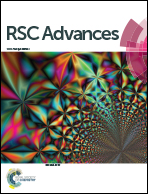Room-temperature synthesis of silica supported silver nanoparticles in basic ethanol solution and their antibacterial activity†
Abstract
A facile and environmentally friendly route was developed to synthesize silica supported silver nanoparticles (Ag NPs) through the reduction of silver ions in basic ethanol solution without adding any other reducing agents or surfactants at room temperature. The structure, morphology and composition of as-prepared samples were characterized by X-ray diffraction (XRD), field-emission scanning electron microscopy (FESEM), transmission electron microscopy (TEM) and X-ray photoelectron spectroscopy (XPS). It was found that the molar ratio of sodium hydroxide to silver nitrate was a decisive factor for the composition of the final products. If the molar ratio was larger than 1.1, the final product was pure silver particles; otherwise, part of the product was silver oxide. Moreover, it was also found that water had a negative influence on the formation of silver particles. For a simple experimental process, this is an efficient and facile method to synthesize silica supported Ag NPs in ethanol at room temperature. Additionally, since the as-prepared Ag NPs were not encapsulated with surface modifier, the Ag NPs with more active atoms exposed consequently exhibited excellent antibacterial activity against Escherichia coli.


 Please wait while we load your content...
Please wait while we load your content...